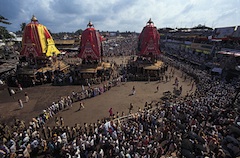|
|
|
|
 |
|
Puri
This page has not been updated since June 2014.
Hindu pilgrimage site
The city of Puri in Odisha state, India, is one of the seven holiest places for Hindus, known as ksetras, where release from the cycle of rebirth can be obtained. Part of the Char Dham pilgrimage route, a visit to Puri is considered essential at least once in every Hindu lifetime. Situated on the East Indian coast it is also famed for its beaches.
 |
 |
 |
Worshippers pull the enormous chariots at the Rath Yatra festival |
Puri derives its sacred status by being the holy land of Lord Jagannath and the Jagannath Temple is the focus of Hindu pilgrimage. This culminates in the annual Rath Yatra festival of chariots, attended by over 1 million pilgrims, when the deities Jagganath, Balabhadra and Subhadra are taken from the temple in 45 ft high elaborately decorated chariots. Pulled by devotees, the procession takes the devotees to the nearby Gundicha Temple where the deities rest for seven days before being carried back. This ritual is the origin of the English word ‘juggernaut’, meaning a large vehicle. There is also a special festival every 18 years which attracts 2.5 million pilgrim.
Among the major environmental issues currently faced in the Puri area waste disposal, sewage, sanitation and encroachment of the land around the temple are significant challenges.
Progress so far
Puri joined the Green Pilgrimage Network at the extraordinary GPN meeting in Trondheim in 2013 and work has begun to draw up a long-term plan.
Hindus from Puri took part in the first ever Hindu Environment Week in March 2014 and organised a full seven days of events, including cleaning temple grounds, tree plantations, and a bicycle expedition. The Jagannath temple took the lead and brought together over 30 different NGOs, along with police officers, life guards, government officials and business leaders.
Useful links
Jagannath Temple website
|
 |
|
|
|
|
|
 |
Green pilgrimage network members
The vision is of pilgrims on all continents and the pilgrim cities that receive them, leaving a positive footprint on the Earth |
 |
Projects overview
A complete listing of all current ARC projects |
 |
The Hindu Declaration on Nature - Assisi 1986
The original Hindu Declaration on Nature was created in 1986, at a meeting held in Assisi by WWF-International. It stemmed from an idea by HRH the Prince Philip, at which five leaders of the five major world religions – Buddhism, Christianity, Hinduism, Islam and Judaism – were invited to come and discuss how their faiths could help save the natural world. |
 |
 |
|
|

